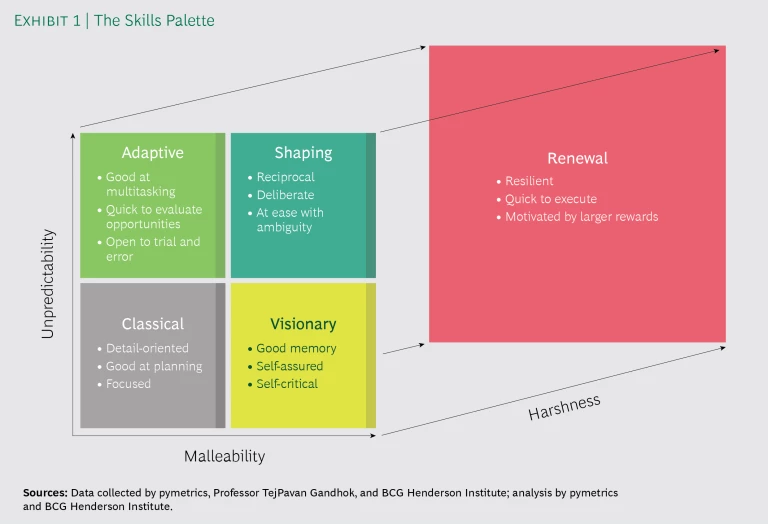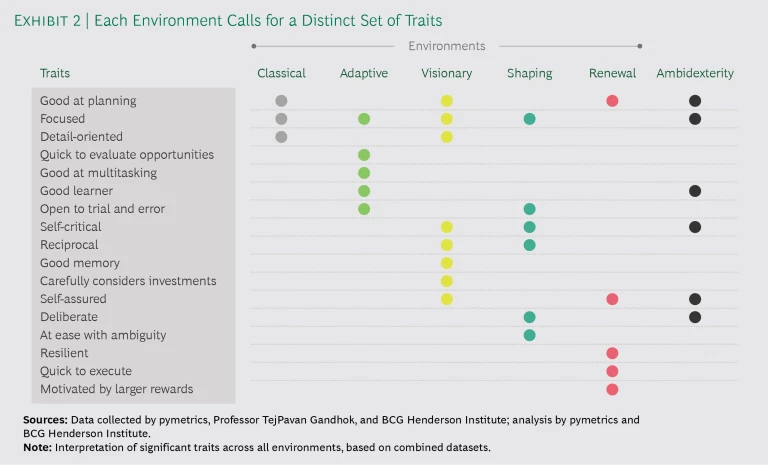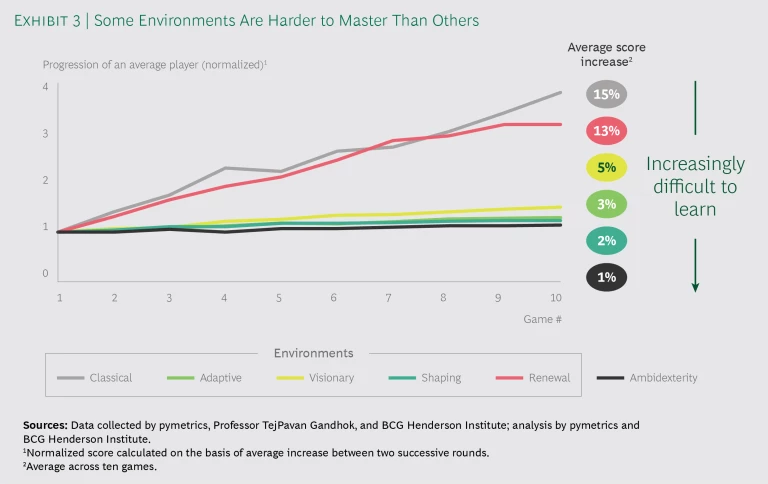Businesses today are competing in an increasingly diverse set of environments: across multiple dimensions, the range of conditions faced by different businesses has increased dramatically since the 1980s.
In BCG’s previous research, published in Your Strategy Needs a Strategy, we identified five distinct business environments, each of which requires its own approach to strategy and execution:
- Classical. For markets that are predictable, analyze the drivers, plan your actions, and execute those actions.
- Adaptive. For markets that are unpredictable, vary your bets, select the most promising ones, and scale them up quickly to detect and capitalize on emerging opportunities.
- Visionary. For markets that can be predicted and shaped, envision the future, build a company that can pursue the defined vision, and persist when you inevitably reach roadblocks.
- Shaping. For markets that can be shaped but not predicted, engage a broad ecosystem of partners, orchestrate their actions, and co-evolve together.
- Renewal. For harsh markets and situations, react promptly, economize resources, and then pivot to grow.
Once an organization has identified the right conceptual approach to strategy, it needs to understand which capabilities are required in order to execute, and how these can be identified. One way to do so is by leveraging the power of games to measure and develop skills consistently and cost effectively. By using games designed to measure performance and behavior in different settings, in combination with artificial intelligence and theories from neuroscience, businesses can identify and develop the right leadership for each strategic environment.
To understand the power of a games-driven approach and identify the traits that best predict success in different environments, the BCG Henderson Institute, pymetrics, and Professor Tejpavan Gandhok from Jindal Global University collaborated to study the strategy skills and neuroscience profiles of around 360 strategists with diverse backgrounds across different regions. We found that different cognitive and emotional traits (also known as cognitive neuroscience measures) reliably predict success in different simulated business environments, and that only a few individuals were able to perform well across all environments. This demonstrates that what it takes to be a good strategist is highly context-dependent — so companies must understand the strategy skills they need for each environment, develop the right talent base, and take a data-driven approach to talent management and development.
Companies must understand the strategy skills they need for each environment, develop the right talent base, and take a data-driven approach to talent management and development.
Different Neuroscience Measures for Different Environments
Our study of strategy skills and cognitive and emotional traits is drawn from two sets of games. In strategy games developed by the BCG Henderson Institute, players operate a virtual “lemonade stand” while facing conditions that simulate one of the five types of business environment. Players are scored on how well they can deploy the right skills for each environment (for example, analysis and planning in the Classical environment, or experimentation in the Adaptive environment).
Our study of cognitive neuroscience measures is based on a series of games developed by pymetrics. In these games, players undertake challenges that test their underlying cognitive or emotional traits (for example, attempting to fill a virtual balloon up to just before its breaking point as a test of risk aversion). Players are assessed on 91 cognitive neuroscience measures based on their actions in each game. (See the sidebar for more detail on each set of games.)
Using Strategy and Neuroscience Games to Assess Strategy Skills
Using Strategy and Neuroscience Games to Assess Strategy Skills
The BCG Henderson Institute developed a strategy game for its clients and consultants to understand the range of strategic environments and the approach required to succeed in them. Players compete against “Bruce Henderson” to operate a lemonade stand in different business environments, aiming to generate more profits than Bruce. In order to win, players need to deploy the right strategy approach for each environment.
For example, in the Adaptive environment, clouds appear randomly above crowds, which then disperse, resulting in lower foot traffic in the area. Players thus need to continuously pay attention to changing conditions and adapt their actions accordingly. Across all environments, players’ actions — such as scouting new locations and choosing how often to move and when to grow — are tracked, scored, and analyzed.
Pymetrics deploys a series of neuroscience-based games to measure individuals’ cognitive and emotional traits (“cognitive neuroscience measures”). Participants play a number of mini-games to this end. A variety of actions, such as speed of reaction or number of right or wrong answers, are tracked and analyzed using pymetrics’ proprietary algorithms to quantify the player’s cognitive neuroscience measures.
For example, in one mini-game, participants are invited to use a pump to inflate a virtual balloon. Each pump earns them money. The choice to pump more and earn more money, however, comes with the risk of popping the balloon and losing everything. Each moment therefore offers the choice between stopping and collecting the money, or further inflating the balloon. Players’ decisions in this game indicate their risk affinity, and the total amount of money they collect indicates their performance when facing risky situations.
By collecting each player’s scores on both sets of games, we built a unique dataset combining strategists’ cognitive neuroscience measures and strategy skills. Using multiple regression analysis, we identified the cognitive neuroscience measures that were most correlated with success in each type of strategy environment. We found that certain traits were reliable signals of strategy skills — but importantly, the traits needed to succeed were different across environments. Below we describe some of the most prominent traits to demonstrate how they contribute to success in the different strategic environments. The full list of statistically significant traits is included in Exhibit 2.
In Classical environments, the most important traits include:
- Detail-oriented: adept at collecting, gathering, visualizing and analyzing information in detail.
- Good at planning: excelling at developing a structured plan by laying out specific steps towards a goal.
- Focused: able to filter out noise and maintain attention on specific tasks.
In predictable and stable environments, the ideal approach to strategy involves analyzing key drivers of the performance and executing a plan to address them. It is not surprising that the best strategists in such environments are able to conduct detailed analysis, create logical plans, and remain focused on them.
The most important traits in Adaptive environments include:
- Good at multitasking: capable of handling several tasks simultaneously.
- Quick to evaluate opportunities: able to assess situations quickly.
- Open to trial and error: willing to try different actions despite understanding that failure may occur.
In more unpredictable environments, strategists must be able to manage a portfolio of bets. As new opportunities emerge and new information about them is revealed, effective strategists quickly select and scale the successful ones in a process of trial and error.
The most important traits in Visionary environments include:
- Good memory: strong ability to recall details of past experiences.
- Self-assured: confident in one’s statements and actions.
- Self-critical: frequently questioning and re-evaluating one’s behavior.
In predictable and malleable environments, strategists must envision new possibilities, which may build upon past experiences. Then they must build the company to make that vision a reality, which requires a balance of self-assurance to persist with the vision as well as self-criticism to question when a change of tactics is necessary to achieve it.
The most important traits in Shaping environments include:
- Reciprocal: willing to give as well as to take.
- Deliberate: acts consciously and intentionally.
- At ease with ambiguity: able to act and decide on partial information.
Unpredictable and malleable environments require mutual trust and reciprocity among stakeholders. Though the foundation for productive ecosystems must be laid carefully and deliberately, ecosystems evolve organically, requiring strategists to be comfortable with the ambiguity that comes from having only partial control.
The most important traits in Renewal environments include:
- Resilient: able to withstand difficult conditions.
- Quick to execute: swift in driving decisions into actions.
- Motivated by larger rewards: filters out low-value opportunities.
Harsh environments and circumstances require strategists to be resilient in order to maintain their focus in the face of a crisis. Bold, pragmatic moves are often required to restore viability, and speed of action can make the difference between success and failure.
Together, these sets of traits demonstrate the skills palette that businesses need to paint with in order to set and execute strategy effectively. (See Exhibit 1.) The optimal skills for strategists vary significantly across each environment.
Ambidexterity Is Rare but Can Be Achieved
As the business world becomes more diverse, not only are companies more likely to face changing strategic environments over time, but they may face multiple environments simultaneously. Therefore, the ideal strategists must not only have the skills to succeed in one environment, but they must be able to master multiple ones — in other words, they must be ambidextrous.
However, truly ambidextrous strategists are quite scarce, comprising about 2% of the population that we studied.
As for each of the five strategic environments individually, we analyzed the cognitive neuroscience measures that were most common among the most ambidextrous strategists. Not surprisingly the profile of ambidextrous strategists combines traits that were important in each environment, including being good at planning, open to trial and error, self-critical, deliberate, and self-assured. (See Exhibit 2.)
The Limits of Traditional Personality Tests
Many organizations today use personality tests to analyze individuals’ preferences, characteristics, and behaviors, with the goal of assessing their fit within a team or company. Plausibly, these psychological profiles could also be used to assess how strategists’ skills and capabilities match their roles. But personality tests differ considerably from cognitive neuroscience measures, both in the traits measured and in the method of measurement. The data derived from cognitive neuroscience instruments comes from measuring objective behavior, whereas traditional personality tests measure self-report of higher-level phenomena.
To test if personality traits are also useful for determining strategy skills, we evaluated participants on two prominent personality profiles — the Big Five and the Rational Experiential Inventory.
We found that, unlike the cognitive neuroscience measures, the personality traits of the Big Five and REI did not consistently predict strategy skills.
All Strategic Approaches Can Be Learned, but at Different Rates
If particular skills are required to succeed in each business environment, can companies develop these capabilities by training strategists to be well-rounded? The answer depends on whether or not strategy skills can be learned, and how effectively. To understand how well each approach can be learned, we measured the rate at which participants’ scores improved on repeated iterations of the strategy game in each environment.
We found that all approaches can be learned, but at very different rates. (See Exhibit 3.) The strategy skills required to succeed in Classical and Renewal environments were learned relatively quickly: In those environments, players’ scores increased by an average of 15% and 13%, respectively, in their first ten games. In contrast, the skills required to succeed in Visionary, Adaptive, and Shaping environments were much more challenging to improve through practice. Mastering Ambidexterity was the most challenging, with an average learning rate of roughly 1% during the first ten games played in each environment.
The difference in learning rates reflects the intrinsic difficulty of decision making in each environment. Classical and Renewal have a relatively well-defined set of levers to drive strategy and execution. Classical environments are stable, so the levers required to win tomorrow can be predicted from analyzing those that worked yesterday; similarly, given the imminent threat to survival in Renewal environments, the initial key success driver is a single-minded focus on rapidly restoring viability through enhanced efficiency.
In contrast, Adaptive, Visionary and Shaping environments are more open-ended: actions in Adaptive environments have unpredictable outcomes; in Visionary environments, the market is malleable and there are no precedents; and Shaping environments combine both sets of characteristics. Consequently, it is comparatively more difficult to learn the necessary approach to succeed in these environments. Finally, Ambidexterity requires being able to cope effectively with all environments, introducing even more complexity.
As companies look to develop their talent, they need to take into account that some skills are harder to learn than others, and they should factor that into their overall talent strategy. For example, companies may seek to hire people with demonstrated skills and experience in difficult-to-learn environments like Shaping, knowing that the required skills cannot be easily acquired. On the other hand, they might adopt a more organic approach for environments in which the required skills can be more easily learned, like Classical.
Five Steps to Build Strategic Capabilities
As companies revamp their strategy and execution to match a variety of business environments, it is critical that they acquire, develop, and allocate the appropriate skill sets. In order to succeed, we propose a five-step approach for managing strategic talent.
1. Diagnose your environment. To determine which strategy approach to pursue, businesses need first to understand the nature of the environments in which they operate and compete. In particular, the unpredictability, malleability, and harshness of the environment have major implications for the appropriate approach to strategy — and the skills required to succeed. In a fast-changing business climate, however, leaders cannot rely on precedent — they must constantly monitor and diagnose whether the environments they face have changed.
For example, Microsoft adjusted its approach to cloud computing along with changes in the environment. As Satya Nadella explained in his book about the company’s transformation, early on the cloud market’s evolution was unpredictable, so the company deployed an Adaptive approach, making multiple bets on cloud capabilities — of which some succeeded, such as Azure, while others failed. As Microsoft gained more ground in the maturing cloud market through successful experiments, the company soon realized it could increasingly mold the market, and therefore adopted a Shaping approach. This involved forming a wider ecosystem around its cloud products — including partnerships with competitors such as Google, Apple, and Linux — effectively utilizing the power of collaboration, as Nadella recognized when he said, “When done right, partnering grows the pie for everyone.”
2. Deploy the right talent for different strategic challenges in different parts of the business. Given the diversity of environments today, many organizations are facing different types of circumstances at once or over time. For example, a company’s legacy business may require a Classical approach, while its newest offerings may instead require, for instance, a Shaping approach. Given the different strategy profiles that are required to succeed in different environments, companies should recruit, retain, and refocus their strategists according to the skills that are needed in each part of the business.
Companies should recruit, retain, and refocus their strategists according to the skills that are needed in each part of the business.
In order to do this effectively, organizations need first to assess and take stock of their talent pool. Only by having a view of the innate skills of its employees (by using games to assess their decision-making traits) can an organization then deploy employees effectively against different strategic challenges. Without having such a view of employees’ innate skills, businesses risk putting their “strategists” in individually suboptimal situations, where they may not have the skills to execute the necessary approach.
An example of a company that employs this philosophy is Zappos, the online shoe and clothing retailer acquired for $1.2 billion by Amazon in 2009. A dedicated group in the organization develops a system of “badges” that are awarded to employees based on their demonstrated skills. “What we’re really trying to do and understand is what skills each and every individual has at the organization” said its lead organizational designer, John Bunch. The company developed a Role Marketplace in which employees looking for a project can apply to join teams looking for help — which in turn use the badges to identify the employees best fitted to the job. By effectively utilizing employees’ skills across various projects, Zappos successfully adapted in a fast-changing market, achieving a 75% year-on-year increase in operating profits in the first year of implementing the model.
3. Maintain a diversity of skills across the organization. Our research showed that it is highly unlikely that an organization will have many ambidextrous leaders, who can succeed in any strategic environment. Therefore, to ensure success in heterogeneous strategic environments, companies need a balanced pool of individuals with different skill profiles.
To ensure success in heterogeneous strategic environments, companies need a balanced pool of individuals with different skill profiles.
Apple in the Steve Jobs era is a great example of embracing a diversity of skill profiles. For example, Tim Cook, then the COO, led Classical parts of the business (such as supply chain management and manufacturing) by leveraging classical strategy skills — Cook described himself as “an engineer and an analytical person at heart.” At the same time, Eddie Cue, then head of internet software and services — including products with uncertain business cases like iCloud and the App Store — was known for recognizing and persevering amid failures, a necessary trait in Adaptive environments: “We have to be honest with ourselves. We’re not perfect, and we’re going to make mistakes,” Cue said. By having the right talent deployed in its various businesses, Apple was able to drive efficiency while constantly developing new growth engines.
4. Broaden people’s skills toward other environments. Organizations need to develop an adequate talent pipeline to ensure a continuous supply of leaders who can succeed in different environments. With business environments rapidly changing — previous BCG research showed that companies cycle through the growth share matrix twice as fast on average as they did 20 years ago — organizations need to continuously broaden their skill sets.
Our research showed that while the rates vary, strategy skills can indeed be learned, indicating that appropriate development programs could make a real impact, at least for some strategic environments. It is not common for companies to have career development programs that explicitly train future leaders to deploy several different strategy approaches. But ambidextrous leaders are increasingly valuable in diverse environments, so companies need to develop career paths across different environments, not only within one of them.
One way to achieve broad-based skill development is to institute a rotational program for managers, in which future leaders take on responsibilities in a variety of business units that require different strategic approaches. For example, Alibaba institutionalized such regular changes at the level of business unit leadership. As former chief strategy officer Ming Zeng wrote, “The program not only helped further develop the skills of top talent, but also demonstrated throughout the entire organization the leadership’s commitment to organizational flexibility.”
5. Master data-driven skill testing and development. To deploy the proposed talent strategy successfully, firms need objective measurements of individuals’ talent and skills, including in relation to strategic challenges they may not have yet experienced. Taking a data and technology-driven approach to talent management has several advantages. First, it improves the company’s ability to match people and situations, ensuring that the company has the right skills for success in each part of the business. Second, it increases the speed at which companies can match skills to strategic challenges. This is increasingly important today, as such changes occur with increasing frequency. Third, it provides a scalable assessment of the entire talent pool, allowing leaders to identify relevant talent from fringe areas of the company to address skill gaps. Fourth, the specific approach suggested here using strategy games and cognitive neuroscience measures is much more accurate than either subjective HR assessments or personality testing.
Since a one-size-fits-all approach to business strategy is no longer adequate in today’s world, companies must also assess, develop, and deploy different skill sets to navigate different environments. A combination of neuroscience and strategy games is an accurate, scalable, rapid, and cost-effective way to achieve this.









